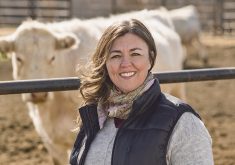What a year for everyone, in every sector, in every single part of the globe. For the first time in most of our lives, we faced a global pandemic. As a pandemic, it saw no boundaries in any industry, in any part of the world.
Every single one of us faced challenges. Same storm, different boats. It was challenge after challenge.
Our ag community was no different. Sure, we are used to seeing more challenges than the average sector — each year we face the unknowns and risks of weather, markets and disruption of our industry.
Read Also

Youth focused on keeping Quebec’s dairy industry strong
In part two of our Making the Future series, Country Guide spoke with Béatrice Neveu from Rawdon, Que. (Read part…
At Farm Life, we wondered if this is what makes us more resilient to weather this storm. Are farmers and the ag community a step up on the rest of the world because we really have “seen it all before?”
We have already had years with zero income. We have battled devastating weather and failing crop outbreaks, export bans and disease. In some ways it feels like every year, we have faced a devastation of some sort. It is just that this year, the rest of the world experienced it too.
We thought about this idea of resiliency in trying times and why it seems the clients we work with are quite optimistic. Sure, there are challenges they face but many of them shared with us that it has really been no different than challenges faced in previous years. One of our clients reminded us, “if you are a farmer, you have to be an eternal optimist.” We wondered if that is what it all really comes down to — an eternal optimism combined with the resilient nature bred into farmers.
We wanted to dive deeper. We wanted to look at what those traits really are, and what makes the farming community who they are. That’s why we are embarking on this series with Country Guide.
Over the past month, we interviewed five different farming families — one in agribusiness, a poultry farmer, both generations of a crop and vegetable operation, and a dairy operation. We tried to get a sense of the common traits that are helping these families weather this storm and the pandemic. Here is what we learned.
The early days of the COVID-19 pandemic were scary. Changing regulations meant farmers were pivoting as fast or faster than any other industry. Children who had not planned to be on the farm were suddenly around during a critical time in their family’s business. Relationships were tested — strengthened and weakened with the community, labour and professional teams.
Those who had farm business management skills and practised business planning were able to adapt at a much quicker rate.
And finally, the operations that embraced innovation saw early wins.
No one we spoke to seemed to fight the idea that innovative measures are required for survival. So that’s where we start this series, taking a closer look at how innovation lifted these farms during the COVID-19 pandemic.

Farmers take control
“COVID-19 hit the fast-forward buttons,” says Warren Jibb, a fourth-generation farmer and dairy farm operator in central Ontario. “A lot of steps we were reluctant to take, we were now forced to take.”
Jibb’s farm, Shadyway Farms Limited, had already adopted an innovative technology through ClimateFieldView which provides satellite imagery of their cropping operation allowing for virtual health diagnostics from agronomists. Comfortable with using this technology from last year, he felt they were in a better position to make additional innovative changes.
“We started by skipping a lot of people we used to deal with and moving to online purchasing,” Jibb says. “The industry is moving this way and I feel those who will be most successful are people who will adapt and those who will use online methods of communicating.
“There will still be a need for a person to come to a farm to help make decisions, but less of a need for that on-the-farm presence. We now make decisions with the information we gather through our data and I feel confident those decisions will be successful.”
Using ClimateFieldView as an example, Jibb says it surprised him how quickly he was able to recognize issues with his crop, whether there were weed escapes, weed control or fertility issues.
On dealing directly with suppliers, he says he did not experience any real growing pains. “I don’t think we struggled too much. For the past few years, we really had been looking at how agriculture was evolving. Things are changing at a rate quicker than we probably realized. And we knew that to be successful, we had to be efficient and had to quickly utilize the facilities that we had and the technology out there.”
On the dairy operations side, since the farm is not robotic, no significant innovative changes were implemented because of COVID-19. Jibb says it was only small changes that were made, such as adding a sink and hand washing station in the milk house for the truck driver to comply with regulations.

The Jibbs weren’t alone. Moving to online commerce platforms and online communication became the norm for many other farm families too. From setting up online fruit and vegetable shops, to developing a new website for a seed dealer, switching to direct deposit for workers, to reconfiguring machinery to allow for more airflow, the speed of innovation allowed these farm clients to stay afloat during these times.
They are quick to point out it is not yet driving new business but rather saving existing dollars and revenues from being completely wiped out.
As Jibb put it in our last conversation, “We had to adapt, become resilient and move ahead.”
Another family we spoke to owns a vegetable growing operation in Kent County in southwestern Ontario, which was among the hardest-hit places based on the number of positive COVID-19 tests. After some early concern whether their offshore workers would arrive in time for planting, this family managed to secure nearly 75 per cent of their offshore workforce.
Now the farm faces a question. Is robotics the ways to go? The family is researching the question intensively. “Our only alternative is to not use any labour at all,” this farmer told us. “In our case, the automatic planter robots would be an eight-year payback. At some point, we will have to make that decision whether we buy into modern technology or have less equipment and go labour-intensive.”
This year forced innovative measures on how they operate planters, for instance creating more airflow under their tarping system to try and keep their workers safe. The costs incurred with PPE (personal protective equipment) and the stress of worrying about migrant workers has them seriously considering moving entirely to robotics.
“The one thing we can count on is innovation will drive the industry. We fully expect whether it’s different equipment or new pieces on existing equipment, I think that will happen for sure and we will have to invest in these changes.”
Farm Life also discovered that being innovative for some brought changes that were not necessarily regulated. A poultry farmer told us stories of having to set up their own processing operation when their finished poultry couldn’t be processed as expected. The demand suddenly changed, and processing plants were unable to handle the capacity due to their limitations on the number of staff and output was slowed.
Another group of producers had to set up their own processing facility to complete their harvest. “We were out of options,” they shared. “It would have destroyed our business to a point we could not recover from. We had to think fast and figure out a way to do it safely … We were able to sell to friends and other family members and save some of our crop.”
This innovation brought together a community of nearby families who worked together to create a solution to this problem. They thought about ideas, and quickly did what they needed to do at the time.
We know from the examples in this article that this is not the way farmers are used to doing business, especially when it came to setting up a temporary processing facility. The reality is that many farmers are faced with having to make decisions to quickly innovate and pivot during these times.
It comes back to that basic question about the power of resiliency and the need for farmers to have a mindset of continual adaptability. As one farm successor put it to us, “the problems come up and you look for solutions.”
Regulated solutions? Not necessarily in all these cases. But innovative? Yes. Resilient as ever.















